|
While the Z06 is really aimed at road racers and autocrossers, the first thing some Corvetters will do with it is head for the drag strip. After 12 years on top; the ZR1 gets booted off the best-accelerating-stock-Corvette hill. Z06 is the quicker "Zed". While Iíve not tested a production example on the drag strip, at the Mid-Ohio preview, GM supplied quarter-mile numbers run by development engineers in prototypes. Under ideal conditions, the car went 12.6/114 with a four-flat, 0-60. Thatís quickĖdamn quick. Even an average, production Z06 in the hands of an average driver on an average track will probably take a stock ZR-1 by a couple of tenths. The three, key enablers in the Zed-ought-six sending the Zed-are-one packing is the new, LS6 engine, a new iteration of the Tremec, six-speed manual transmission and the sticky Goodyear Supercar tire. Americans, born and raised on conspicuous consumption, like big, thumping V8s in their sports cars. John Juriga, Integration Manager for the Corvette engine program at GM Powertrain Division (GMPT), often says, "The engine is the heart and soul of a Corvette." We like the way he thinks. On June 11, 1996, General Motors previewed a totally new V8 engine design to the automotive press. Known to engineers working on the project as "Gen3," the roll-out version was the high-performance, all-aluminum variant, RPO LS1, first used in the 1997 Corvette. LS1 was a home run right out of the box. It mixed cutting-edge technology with proven pushrods and two-valves-per-cylinder and combined that with state-of-art block, cylinder head and induction system designs. The result was a 345 cubic inch V8 that produced one SAE net horsepower per cubic inch, remarkable for an engine with eight-valve heads and pushrod valve gear. It did that for less cost than an overhead cam engine and with a design that, in iron block form, could be shared with millions of full-sized trucks and SUVs. For two years, LS1 has been on the Wards Auto World 10 Best Engine list. For more about the LS1, point your browser at: www.idavette.net/hib/ls1c.html . In í97, I asked sources close to the Gen3 project about iterations more powerful than LS1. One off-the-record answer was something like, "Weíve got development versions running on dynos at the 400hp level right now." By late-í98, the RPO "LS6" had leaked out and the rumor mill churned. I still chuckle at Internet speculation that LS6 had 450hp or was just an LS1 with different ECM calibration.
Finally, the Beacon of Reality cuts through the fog. Itís not 450hp, but itís a hell of a lot more than a different ECM calibration. LS6ís very core is unique. The LS1 had had less-than-optimum high-rpm oil control, so GMPT set-out to improve that with a special block. It was revised at the base of the cylinders to improve "bay-to-bay" breathing. As the pistons move up and down, they force air in-and-out of the spaces (or "bays") beneath them. At high rpm, this reciprocating air flow is violent and really whips up the oil. While the LS1 block has some machined openings between bays, the LS6 block has larger "windows" at the base of each cylinder that better accommodate bay-to-bay breathing. The positive crankcase ventilation (PCV) system was also changed. Taking a page out of the LT5ís book, the LS6 gets a valley-mounted oil separator. This both reduces oil aeration and simplifies the PCV system. All this improves oil control, reduces oil consumption, reduces parasitic power loss and contributes to the LS6ís 500 additional, usable rpm. A traditional way to make more power is put in a bigger cam. The LS6 camshaft has more lift and more overlap. It gets the valves open more, opens them quicker and runs to a higher rpm. LS6ís also have better valve springs to tolerate more lift at higher rpm. No doubt, the biggest performance change from LS6 comes with its cylinder heads. Changes in intake and exhaust ports increase air flow in and exhaust flow out. A slightly smaller combustion chamber ups the compression ratio to 10.5:1. Lastly, the water jackets were altered for improved cooling performance.
Lastly, the LS6ís engine controls calibration was changed to one appropriate for the additional air and fuel flow and having a 6600 rpm rev limit.
John Juriga offered up this sound bite, "The LS1 already was the best overhead valve engine and the LS6 brings it up another level. This is a very high-performance engine perfectly suited for everyday driving. It's safe to say it is a benchmark for the world. That the same exact heads are going to go on the 6.0-liter LQ9 used in light trucks for 2001 says much about the LS6ís durability, as well. "The LS6 V8 might be the best validation of a
simple philosophy: continuous refining of This look at the technical side of the LS6 has been brief. This fall, GM High-Tech Performance Magazine will publish a feature article covering the LS6 in depth. Be watching for it.
|
|||
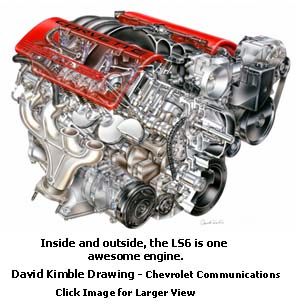
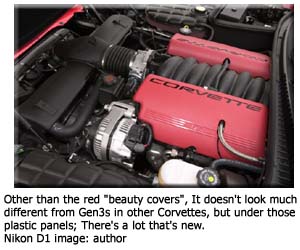
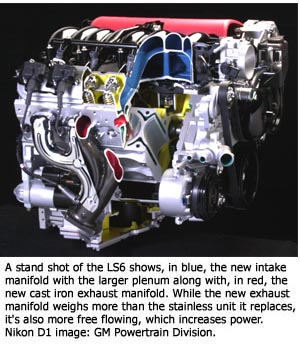
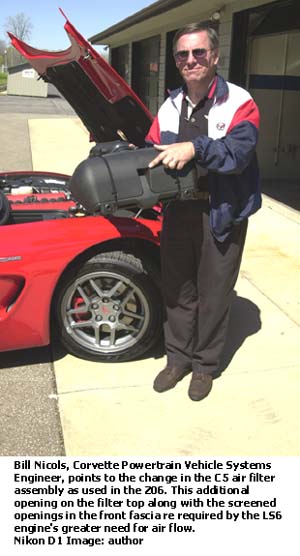
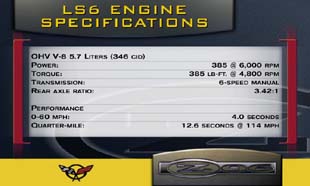
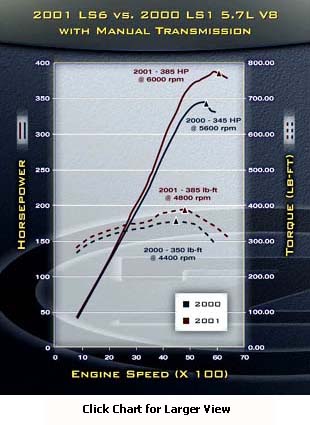
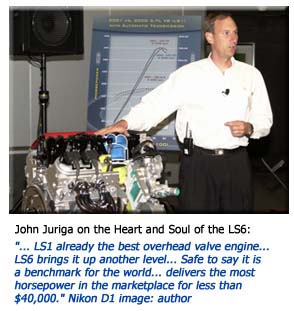 existing technologies can be more cost effective and more satisfying to
the customer than developing new ones. Proof lies in the fact that its
predecessor, the LS1, already delivers the most horsepower available in
the automotive marketplace for less than $40,000."
existing technologies can be more cost effective and more satisfying to
the customer than developing new ones. Proof lies in the fact that its
predecessor, the LS1, already delivers the most horsepower available in
the automotive marketplace for less than $40,000."